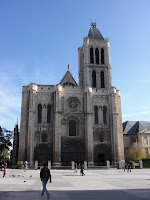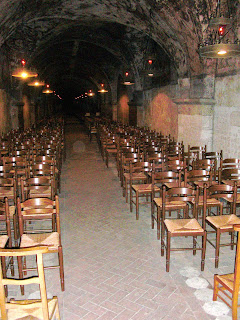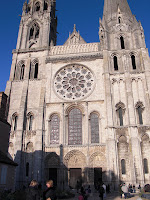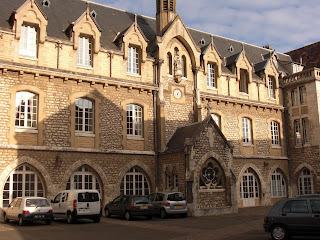"Experience, travel -- these are as education in themselves." - Euripedes, Greek playright (480-406 BC)
Our last day in Vienna, and it seems colder and darker than before. Then the realization hits you that
you're in Vienna and there are more wonders awaiting! So you triple-layer your clothes, put on the well-worn scarf and gloves, and head out for more -- as oblivous to the weather as possible.

It's back down to the city center and right turn at the opera house that leads to a large pedestrian square and the imposing figure of St. Stephen's Cathedral. Unlike the austere
parvis that fronts on Chartres Cathedral, St. Stephen's is situated amid the newstands, souvenir hawkers, and sausage vend

ors dwarfed in its shadow.
St. Stephen's is a beloved Viennese landmark, known for its multi-colored tile roof (a sort of mosaic in sections that depicts the Hapsburg crest and other historic symbols) and its survival through a tumultuous Austrian history (including the wooden rafters of its roof being destroyed during World War II).

Built on the site of an ancient cemetery with graves dated back to the 4th century, the original 12th century cathedral was a Romanesque structure that eventually made a full evolution to late Gothic with major construction ceasing in the early 16th century. Two major fires during that period resulted in renovations that continually updated the Gothic elements of the building.
It was here, allegedly, that Beethoven realized the full extent of his deafness as he watched birds flee the towers when the bells were rung (and he couldn't hear them). Mozart was adjunct music director at St. Stephen's; he was married here, saw his children baptized here, and his funeral was held here.
Beyond the "luminous" lore associated with this cathedral, it's easy to see why the French still lay claim to the best of Gothic. The interior of St. Stephen's is dark and confusing, perhaps a result of the numerous re-workings of its plan through the centuries. St. Stephen's nave is crowded with mis-matched side-chapels; Chartres is blissfully devoid of this distraction. In St. Stephen's, elaborate baroque and rococo elements bombard the eye in a dizzying display of shapes and shadows. There's no clear ambulatory, and navigating through the nave is confusing at best. The mood is dark and foreboding.
In Chartres, the symmetry of the nave and the clarity of direction (upward and toward the crossing) draw you in, colored light cuts through the empty nave at the upper levels, and ornamentation is largely kept at eye level so as not to disrupt flow. In contrast to the over-stimulation, murky shapes, and mix of styles of St. Stephen's, it's a soothing, calming sense that bids you in and "lifts' the spirit.
(An interesting direction in research would be to compare/contrast French Gothic with that of Italy, Germany, Austria, England, or Spain and show how cultural or historical differences are illustrated in each country's adaptation of the style... )
Strolling behind St. Stephen's, we come upon a museum we'd both been looking forward to visiting: Mozart's House. For the approx. US$ 15 price of admission, you'd expect to perhaps see his harpsichord, a few sheets of original manuscript, a piece or two of his furniture, his personal effects or perhaps a powdered wig? But no! The apartment rooms were bare except for the framed
copies of notables who were Mozart's contemporaries (most of whom are never mentioned in the recorded visit guide). There's an empty room that
might have been h

is bedroom, another that
might have been his study, some
copies of Haydn's will (doesn't he have his own museum?), a reproduction of a waistcoat like one Mozart
might have worn, a copy of a portrait that
might be that of Mozart's wife, and a few other head-scratching displays of dubious taste thrown in. A big disappointment, one that cried out for
sacher torte afterwards at a nearby cafe. :-)
 elearn?) that Dave's undergrad degree is in art, and he is a fellow "art nerd" with a few art history courses under his belt. This discovery leads to an afternoon excursion to downtown Middletown, Ohio to the Riordan Stained Glass Studio. The oldest such studio in the country, it's a veritable gem on a bleak, wintery day in a city that's been through hard times lately. Vicki lives in an historic, 19th century home and got to know the studio's owners and artists when she and her late hu
elearn?) that Dave's undergrad degree is in art, and he is a fellow "art nerd" with a few art history courses under his belt. This discovery leads to an afternoon excursion to downtown Middletown, Ohio to the Riordan Stained Glass Studio. The oldest such studio in the country, it's a veritable gem on a bleak, wintery day in a city that's been through hard times lately. Vicki lives in an historic, 19th century home and got to know the studio's owners and artists when she and her late hu sband commissioned a period reproduction stained glass panel for their stairway landing. She and Dave were eager to introduce us and let us have a peek at the jewels created within the walls of what I remember as the old Murphy's Five-and-Ten (way back in the '60s)!
sband commissioned a period reproduction stained glass panel for their stairway landing. She and Dave were eager to introduce us and let us have a peek at the jewels created within the walls of what I remember as the old Murphy's Five-and-Ten (way back in the '60s)!




 Built on the site of an ancient cemetery with graves dated back to the 4th century, the original 12th century cathedral was a Romanesque structure that eventually made a full evolution to late Gothic with major construction ceasing in the early 16th century. Two major fires during that period resulted in renovations that continually updated the Gothic elements of the building.
Built on the site of an ancient cemetery with graves dated back to the 4th century, the original 12th century cathedral was a Romanesque structure that eventually made a full evolution to late Gothic with major construction ceasing in the early 16th century. Two major fires during that period resulted in renovations that continually updated the Gothic elements of the building.
















 There's one marked distinction at St-Denis over other French Gothic cathedrals. It seems most of the available floorspace outside of the nave is covered with recumbent statues (funereal statues representing the person entombed there). There's Francois I and Henri IV, even a cenotaph of a kneeling Louis XVII and Marie Antoinette (a cenotaph is a funereal monument where the body is not present -- in the case of this pair, the remains were lost during the chaos of the Revolution). As I learn from my pamphlet, the 12th century statues show the dead with open eyes, while the compositions grow larger and grander during the Renaissance and the subjects have closed eyes (illustrating death with the hope of resurrection).
There's one marked distinction at St-Denis over other French Gothic cathedrals. It seems most of the available floorspace outside of the nave is covered with recumbent statues (funereal statues representing the person entombed there). There's Francois I and Henri IV, even a cenotaph of a kneeling Louis XVII and Marie Antoinette (a cenotaph is a funereal monument where the body is not present -- in the case of this pair, the remains were lost during the chaos of the Revolution). As I learn from my pamphlet, the 12th century statues show the dead with open eyes, while the compositions grow larger and grander during the Renaissance and the subjects have closed eyes (illustrating death with the hope of resurrection).









 the nave with the altar) of the cathedral – barely a stone’s throw away.
the nave with the altar) of the cathedral – barely a stone’s throw away.
 the Beautiful God that welcomed the faithful at eye level as a benevolent, handsome deity incarnate, in stark contrast to Christ the Judge who oversees the weighing of souls at the portal of the Last Judgment. The entire story of man’s creation, fall from grace, and salvation is richly and exquisitely told in layers on this building. It should be read and digested in chapters to appreciate it all!
the Beautiful God that welcomed the faithful at eye level as a benevolent, handsome deity incarnate, in stark contrast to Christ the Judge who oversees the weighing of souls at the portal of the Last Judgment. The entire story of man’s creation, fall from grace, and salvation is richly and exquisitely told in layers on this building. It should be read and digested in chapters to appreciate it all!


